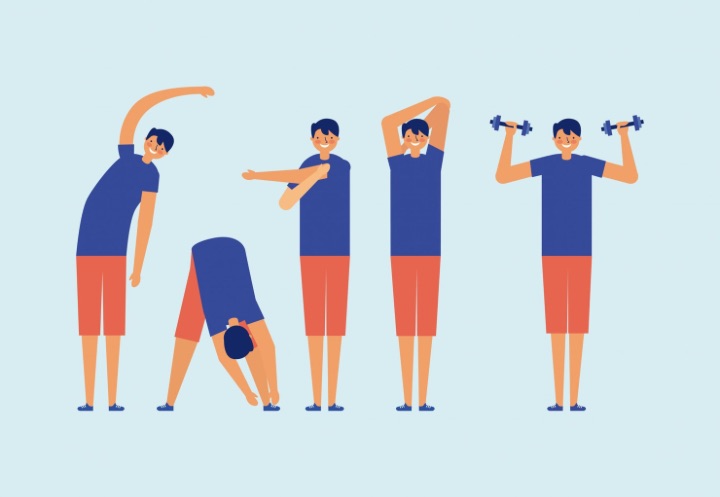“Text neck” is a term for the neck pain and damage sustained from looking down at your mobile phone, tablet, or other wireless devices too frequently and for too long. This repetitive stress injury happens because the human head, which weighs about 4.5-5.4 kilograms when in a neutral position, can exert a force of about 27 kilograms on the neck when bent at a 60-degree angle.
Symptoms include neck pain, stiffness, soreness, reduced mobility, upper back pain, shoulder discomfort, and recurring headaches. It’s preventable and correctable with improved posture, exercises, and taking breaks from screens.
Text neck syndrome is a modern-day condition that occurs due to prolonged, excessive use of mobile phones and other handheld devices. Commonly referred to as smartphone or tech neck, this condition results from the forward head posture adopted while using these devices.

Photo Credit: 8photo
Individuals with this syndrome experience a common neck strain due to the excessive use of mobile devices. The strain occurs due to the neck and head relationship, which places undue pressure on the cervical spine.
This pressure can cause the neck muscles to overwork, leading to tension, stiffness, or soreness in the neck and shoulder areas.
Text neck is caused by prolonged poor posture while using mobile devices and laptops. The position of the head while using these devices is such that it is tilted forward, causing strain on the cervical spine. This strain can lead to neck pain, headaches, and other related symptoms.
The primary cause of this condition is the posture individuals take while they use their mobile devices. The tendency to hunch over the device leads to the development of text neck posture. This posture strains the cervical spine and can cause cervical lordosis, an abnormal inward curvature of the neck.
This can also result from injuries, such as whiplash or other trauma to the cervical spine. These injuries can lead to acute or chronic neck pain and further exacerbate the issue of text neck. Long periods of sitting or standing in the same position can also cause this condition, leading to neck muscle strain and tension.
One of the most effective ways to alleviate text neck symptoms is to regularly perform neck stretches and exercises. These exercises can help strengthen the neck muscles and improve posture. Some common exercises include:
In addition to exercises, correcting the forward head position is crucial in treating this condition. This can be achieved by keeping electronic devices at eye level, using a stand or holder to keep devices at a comfortable viewing angle, and taking frequent breaks to stretch and move.
For those experiencing neck and shoulder pain, neck support or a brace may help provide extra support and reduce strain on the cervical spine. However, it is important to consult with a healthcare professional before using neck support.

Photo Credit: gstudioimagen
You can manage and prevent text neck symptoms by incorporating these treatment options into your daily routine. Remember to take breaks, stretch regularly, and maintain good posture while using electronic devices to avoid further discomfort.
Prevention is key to managing text neck and avoiding further discomfort. Here are some tips for maintaining proper cervical spine alignment and finding relief from symptoms:
By implementing these prevention methods, you can avoid the development of text neck and maintain a healthy cervical spine.
Recently, one of the most significant issues mobile device users face is the development of text neck. This condition arises from the constant strain and pressure caused by the forward head posture while using these devices.
The cervical spine is highly vulnerable to strain, and this condition leads to numerous symptoms, including neck pain and discomfort. It is imperative to raise awareness about this issue and acknowledge its impact on cervical spine health.
The cervical vertebrae are delicate and are susceptible to strain from the neck’s excessive bending and poor posture. Regularly maintaining proper posture can prevent text neck and other related issues.

Photo Credit: Freepik
Proper cervical spine alignment and conscious device use can also help prevent this condition. Avoiding prolonged periods of mobile device usage and taking breaks in between can help reduce neck tension.
Neck tension arises from the strain caused by the forward head posture and can lead to discomfort. It is important to take preventive measures to avoid further discomfort. The rising concern has increased awareness about the condition and its potential risks.
The impact of this syndrome on cervical spine health cannot be understated. Acknowledging the importance of maintaining proper posture while using mobile devices and technology to prevent neck strain and discomfort is crucial.
Early intervention and treatment for text neck symptoms can help prevent further damage and maintain cervical spine health.
Managing text neck can be challenging, but numerous resources are available to help alleviate symptoms and prevent further strain on the cervical spine. Here are some additional resources for text neck management:
Correcting posture is an essential component of managing this condition. Resources such as ergonomic chairs, height-adjustable desks, and laptop stands can help create a workspace conducive to proper posture. Some smartphone apps can also remind individuals to take breaks and adjust their posture throughout the day.

Photo Credit: DCStudio
Neck supports, such as cervical pillows and neck braces, can help relieve neck tension and promote proper alignment. A physical therapist can recommend specific exercises and devices for individuals with more severe symptoms to provide additional support.
Ignoring symptoms can lead to long-term consequences, such as cervical spine degeneration. It is essential to prioritize text neck prevention and treatment to maintain optimal cervical spine health. If symptoms persist, it is recommended to consult with a medical professional for further evaluation and treatment.
By utilising these resources and taking preventative measures, individuals can manage and alleviate the symptoms, reducing the impact on their cervical spine health.
Yes, “text neck” can be corrected by adopting healthy postural habits, performing exercises that strengthen the neck and upper back muscles, taking regular breaks from screen time, and using mobile devices at eye level when possible.
Symptoms of text neck can include:
To alleviate text neck quickly:
Pain is typically felt in the neck, shoulders, and upper back. In some cases, it can cause headaches. The pain often intensifies with certain postures, such as bending the head forward or looking down for prolonged periods.